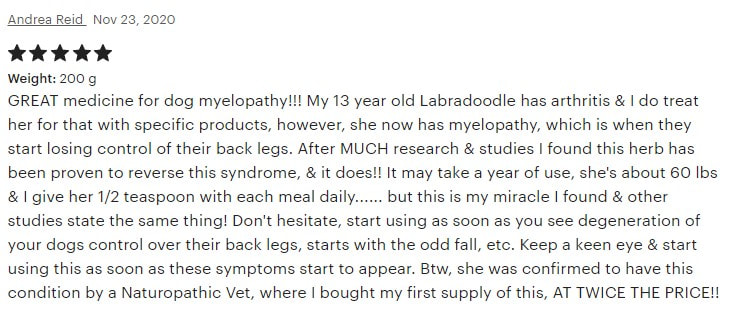Degenerative Myelopathy |
|
By Canine Generic Diseases
What is Degenerative Myelopathy? Degenerative myelopathy is a progressive disease of the spinal cord in older dogs. The disease has an insidious onset typically between 8 and 14 years of age. It begins with a loss of coordination (ataxia) in the hind limbs. The affected dog will wobble when walking, knuckle over or drag the feet. This can first occur in one hind limb and then affect the other. As the disease progresses, the limbs become weak and the dog begins to buckle and has difficulty standing. The weakness gets progressively worse until the dog is unable to walk. The clinical course can range from 6 months to 1 year before dogs become paraplegic. If signs progress for a longer period of time, loss of urinary and fecal incontinence may occur and eventually weakness will develop in the front limbs. Another key feature of DM is that it is not a painful disease. Degenerative myelopathy is a devastating disease causing progressive paralysis in a large number of dog breeds. New research has identified a gene that is associated with a major increase in risk of the disease. |
|
What causes Degenerative Myelopathy? Degenerative myelopathy begins with the spinal cord in the thoracic (chest) region. If we look under the microscope at that area of the cord from a dog that has died from DM, we see degeneration of the white matter of the spinal cord. The white matter contains fibers that transmit movement commands from the brain to the limbs and sensory information from the limbs to the brain. This degeneration consists of both demyelination (stripping away the insulation of these fibers) and axonal loss (loss of the actual fibers), and interferes with the communication between the brain and limbs. Recent research has identified a mutation in a gene that confers a greatly increased risk of developing the disease. How is degenerative myelopathy clinically diagnosed? Degenerative myelopathy is a diagnosis of elimination. We look for other causes of the weakness using diagnostic tests like myelography and MRI. When we have ruled them out, we end up with a presumptive diagnosis of DM. The only way to confirm the diagnosis is to examine the spinal cord under the microscope when a necropsy (autopsy) is performed. There are degenerative changes in the spinal cord characteristic for DM and not typical for some other spinal cord disease. |
|
What else can look like degenerative myelopathy?
Any disease that affects the dog’s spinal cord can cause similar signs of loss of coordination and weakness. Since many of these diseases can be treated effectively, it is important to pursue the necessary tests to be sure that the dog doesn’t have one of these diseases. The most common cause of hind limb weakness is herniated intervertebral disks. The disks are shock absorbers between the vertebrae in the back. When herniated, they can cause pressure on the spinal cord and weakness or paralysis. Short-legged, long back dogs are prone to slipped discs. A herniated disk can usually be detected with X-rays of the spine and myelogram or by using more advanced imaging such as CT scan or MRI. Other diseases we should consider include tumors, cysts, infections, injuries and stroke. Similar diagnostic procedures will help to diagnose most of these diseases. If necessary, your veterinarian can refer you to a board certified neurologist who can aid in diagnosing degenerative myelopathy. A directory to a neurologist near you can be found at American College of Veterinary Internal Medicine website under the "Find a Specialist Near You" link. How do we treat degenerative myelopathy? There are no treatments that have been clearly shown to stop or slow progression of DM. Although there are a number of approaches that have been tried or recommended on the internet, no scientific evidence exists that they work. The outlook for a dog with DM is still grave. The discovery of a gene that identifies dogs at risk for developing degenerative myelopathy could pave the way for therapeutic trials to prevent the disease from developing. Meanwhile, the quality of life of an affected dog can be improved by measures such as good nursing care, physical rehabilitation, pressure sore prevention, monitoring for urinary infections, and ways to increase mobility through use of harnesses and carts. Sourced from: https://cgd.missouri.edu/?page_id=326 |
Why Early Diagnosis of Canine Degenerative Myelopathy (DM) Is Important
|
By Dr. Becker
Degenerative myelopathy, or DM, is a disease of the spinal cord in dogs. It typically occurs between the ages of 8 and 14. Younger dogs can acquire the disease, but it is uncommon. DM is most often seen in German shepherds, but other large breed dogs can be affected, including the Belgian sheepdog, Chesapeake Bay retriever, Great Pyrenees, Labrador retriever, Old English sheepdog, Rhodesian ridgeback, and the Weimaraner. Degenerative Myelopathy Symptoms The disease begins with the loss of coordination in the hind limbs. Dogs with degenerative myelopathy wobble when they walk, they can knuckle over, or they can begin dragging their hind feet. The first symptoms usually occur in one hind limb and then affect the other. As the disease progresses, the limbs become weaker and the dog has difficulty standing. Ultimately, the dog becomes unable to walk. The course of DM ranges from about six months to a year before a dog is paraplegic, losing complete function of the rear limbs. Sometimes the disease continues to progress, causing a loss of bladder and bowel control and eventually, weakness will also develop in the front limbs. As devastating as the disease is, fortunately, it is not a painful condition for the dog. |
|
In DM, the myelin sheath that protects the spinal neurons begins to disintegrate, which exposes the underlying nerve fibers and disrupts the communication pathways between the brain and the spinal cord.
The myelin coating around the spinal cord is crucial for healthy brain-body communication. When myelin degenerates, so does the ability of the brain to send commands to the limbs, and for sensory information to travel from the limbs to the brain. Causes of Canine Degenerative Myelopathy It is suspected DM is an immune-mediated disease somewhat like MS in people. The dog’s immune system attacks its nervous system. Other theories of why DM occurs include toxins, vitamin deficiencies, oxidative stress, or an underlying spinal injury. Because DM is prevalent in certain breeds, a genetic component is likely. Recent research has identified a mutation in a gene that confers a greatly increased risk of developing this disease. Diagnosis DM is a diagnosis of elimination. In other words, many other diseases must be ruled out before a definitive diagnosis can be made. These include a herniated disc or intervertebral disc disease, infections, injuries, cysts, tumors, and stroke. Since many of the diseases with similar symptoms can be successfully treated, it’s important to rule all of them out first. |
|
Diagnostic tests to rule out other diseases include myelography and an MRI.
Once a presumptive diagnosis of DM is made, the only way to absolutely confirm it is to examine the spinal cord during autopsy to check for degenerative changes that are normally seen in DM but are not seen in other spinal cord diseases. Options for Managing the Disease Unfortunately, degenerative myelopathy is a progressive disease with no cure, and there are no drug protocols that have consistently worked to slow the degeneration. Once a dog has been diagnosed with DM, the treatment goal is to manage the consequences of the disease and maintain good quality of life for as long as possible. Dogs with degenerative myelopathy can experience a number of secondary problems resulting from the disease, including urine retention, urinary tract infections, weight gain and muscle loss from inactivity, skin lesions from incontinence, and bedsores as well. Once a dog is diagnosed with DM, scrupulous nursing care will be required for the duration of his life. In my opinion, the very best approach to managing this condition is with an integrative protocol instituted at the earliest onset of clinical signs. A key to maintaining a DM dog’s quality of life and slowing the progress of the disease is maintaining rear limb muscle tone. Regular exercise such as walking for as long as the dog is able, in addition to range of motion exercises and other forms of physical therapy can delay the muscle atrophy associated with DM and maintain mobility and muscle strength for as long as possible. This is absolutely critical. Hydrotherapy and targeted exercises to maintain rear limb strength may also slow the progression of this disease and help dogs with DM maintain strength, balance, and mobility for a much longer period of time. Acupuncture can also be very beneficial in stimulating the nervous system of these dogs. As the disease progresses, there are a variety of harnesses, wheelchairs (or carts, as they’re called for dogs), boots and slings that can also help to improve quality of life and maintain mobility. |
|
Potentially Beneficial Supplements
Most holistic veterinarians, including me, recommend dietary supplementation for dogs with degenerative myelopathy. In addition to a fresh food diet, two supplements -- aminocaproic acid and N-acetylcysteine, also called NAC -- have proved beneficial (and very much so in some cases) in slowing the progression of the disease. Additionally, vitamins E (with selenium) and C, B-complex vitamins, ubiquinol, bromelain, as well as herbs such as ginseng and gingko, are also recommended. Adding omega-3 fatty acids such as salmon or krill oil, as well as a source of GLA, which are the gamma-linolenic acids like blackcurrant seed oil, are also suggested. In addition, I recommend you consider adding a potent antioxidant such as grape seed or pine bark extract, both of which can be beneficial. Most importantly, if your large breed dog is developing rear limb weakness, I strongly encourage you to visit your veterinarian as soon as possible. The earlier a diagnosis is made, the faster you can begin aggressively supporting your dog with targeted muscle-building exercises and an excellent nutritional supplement protocol. |
Canine Degenerative Myelopathy Test Moves Toward Trial
Researchers from the University of Missouri are looking for dogs for the clinical trial.
BY VETERINARY PRACTICE NEWS EDITORS
Published: 7-27-2017
BY VETERINARY PRACTICE NEWS EDITORS
Published: 7-27-2017
|
Similarities between dogs and people are well studied, so it’s unsurprising that researchers discovered a test used to diagnose amyotrophic lateral sclerosis (ALS) in people is applicable to identifying degenerative myelopathy (DM) in dogs.
The genetic link between the diseases was established in 2009 by Joan Coates, DVM, Dipl. ACVIM, a professor at the University of Missouri (MU) Department of Veterinary Medicine and Surgery, and other researchers at the Broad Institute at MIT and Harvard. While the current genetic test for DM can identify risk for the disease, it’s limited in its ability to diagnose it. Therein lies the problem, because as of now, a proper DM diagnosis is time-consuming and expensive, requiring procedures such as MRIs of the spinal cord, according to Dr. Coates. “DM is a diagnosis of exclusion, meaning that veterinarians must rule out all other diseases that mimic it before coming to a final diagnosis,” Coates said. “Now that we know that DM and ALS are related, we are studying ways to diagnose and measure disease progression with similar diagnostic modalities used in ALS patients.” Coates and her MU colleagues have developed a simple DM diagnostic test based on a similar one used to diagnose ALS in humans. Specifically, they found elevated levels of phosphorylated neurofilament heavy proteins (pNF-H) in the cerebrospinal fluid and blood samples—the same biomarkers appear in humans with ALS—of dogs with DM compared to dogs without it. “These results will enable us to ‘scale up’ the test to make it more accessible to [the] veterinary community,” Coates said. “pNF-H may serve as a diagnostic tool for diagnosis of DM.” With the link between ALS and DM established and a new test making diagnosis easier, now Coates and her team are seeking pets to take part in a clinical research trial into treatments for DM that slow its progression and improve the patient’s quality of life. The MU research team is collaborating with other ALS scientists, and the studies are being funded by the ALS Association and National Institutes of Health. “Dogs suffer from more than 350 genetic disorders, many of which resemble human conditions,” said Ewen Kirkness, Ph.D., a molecular biologist at the Institute for Genomic Research, now the J. Craig Venter Institute, in Rockville, Md. “The genes responsible for these are probably constant to humans and dogs.” The research by Coates and others shows that benefits can be derived by taking a closer look at these links. “I was very excited by the idea that there could be another model that might have more strength than the existing models,” said Michael Garcia, Ph.D., an assistant biology professor and principal investigator at the MU Bond Life Sciences Center, who is working with Coates on the research, about the new DM diagnostic test. The DM treatment trial will occur at the MU Veterinary Health Center Small Animal Hospital; dog owners interested in their pet participating can email [email protected]. A supplement being used by many to possibly help slow the progression of the disease.
click image above Degenerative myelopathy (DM) is a frustrating and heartbreaking condition for which modern medicine has no cure. Most veterinarians typically have nothing to offer. Even the help of trained rehabilitation therapists may not be enough to stop the heartbreaking progression to complete paralysis.
What if that decline could be halted? What if we could even turn back the clock a little bit in DM dogs? DM used to be described as ‘doggy MS’, but the disease is much more like the human disease known as ALS. Dogs with DM have a mutation in the gene that codes for the SOD-1 (superoxide dismutase) enzyme. Instead of acting as an antioxidant, the enzyme creates “excitotoxicity” by causing a build up of glutamate in the spinal cord. As in ALS, that build up is toxic to nerves, causing them to slowly die. There’s no highly effective drug for ALS that we can borrow for the treatment of DM, but plenty of research has demonstrated the possible utility of plants for the condition. Laboratory testing has shown that certain herbs can help decrease SOD in tissues and help protect neurons from dying from excess glutamate. We’ve integrated some of the most powerful of them into the DM Formula, which is an adaptation of the two-thousand-year-old formula known as Minor Bupleurum Combination (Xiao Chai Hu Tang). If mutant SOD levels can be lowered and glutamate-induced injury mitigated, neurons in DM dogs that have not been fatally injured may return to some degree of normal function. Disease progression might be halted, and some animals may experience a return of strength and coordination. Stabilization and improvement of DM dogs may be more likely if the patient is fed a real food diet that lowers the risk of oxidative stress and spinal cord inflammation. Improvement is also more likely if the patient is under the care of a rehabilitation therapist or physiotherapist. Specific treatments that may help include mobilization of the spine using massage and gentle chiropractic; the reduction of cord inflammation using anti-inflammatory acupuncture and laser treatments; and the reduction of oxidative stress using ozone therapy. Also add in some Turmeric... |
Now there is a test you can do at home
to see if your dog has the gene
**Canine Arthritis And Joint is intended for informational, educational and entertainment purposes only and is not a substitute for medical advice, diagnosis or treatment. Do not attempt to self-diagnose or treat any health condition. You should always consult with a healthcare professional before starting any diet, exercise or supplementation program, before taking any medication, or if you have or suspect your pet might have a health problem. The opinions expressed by Canine Arthritis And Joint are not to be replaced for medical care. This website and the information contained herein have not been evaluated by the Food and Drug Administration. The information and opinions on Canine Arthritis And Joint are not intended and cannot be used to diagnose, treat, cure, or prevent any disease. This applies to people and pets!
This site uses affiliate links such as banners you may see that allows for paid commissions.
This site uses affiliate links such as banners you may see that allows for paid commissions.
Canine Arthritis And Joint © Copyright 2015-2024
Designed By Paw Prints Web Design
Designed By Paw Prints Web Design















